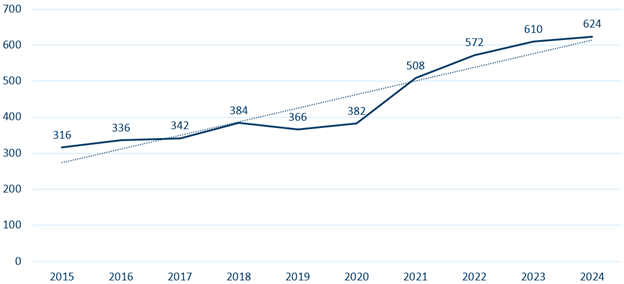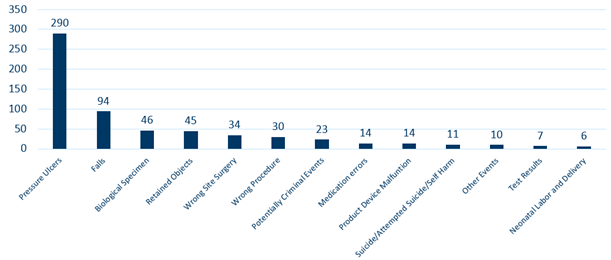News Release
June 24, 2025
Reported adverse health events see slight increase in 2024, smaller than previous years
The latest adverse health events data issued by the Minnesota Department of Health (MDH) showed the smallest increase in preventable errors since before the COVID-19 pandemic.
After recording unprecedented increases that saw the number of annually reported adverse health events jump more than 66% from pre-pandemic levels between 2020 and 2023, Minnesota hospitals and ambulatory surgery centers reported a total of 624 events in 2024, up 14 from 2023. It is the smallest increase in preventable errors since adverse events fell between 2018 and 2019.
Total reported adverse health events 2015-2024

“We are glad to see the rate of increase in the number of adverse health events beginning to slow,” said Minnesota Commissioner of Health Dr. Brooke Cunningham. “Thankfully, these types of patient harms continue to be rare when viewed against overall volume. However, we believe many, if not most, of these events are preventable and we are committed to working with providers through education and analysis to advocate for patient safety.”
MDH’s adverse health events data report includes records collected from health care providers from Oct. 7, 2023, to Oct. 6, 2024. In addition to the modest rise in total adverse health events, the data also revealed that preventable errors that resulted in severe injury or death remained steady at 238. It is the same total recorded in 2023; however, there were two fewer deaths (14). This marked a second straight year with a decline in deaths, which peaked at 21 in 2022.
Number of reported severe injury adverse health events 2015-2024

A portion of Minnesota’s adverse health events in 2024 can be attributed to the elevated level in the length of patient hospital stays Minnesota continues to experience, which increase the risk of experiencing an adverse health event, and a rise in the number of surgeries performed. The high level of lengths of stay can stem from things like increased patient complexity due to delayed care, Minnesota’s aging population, systemic issues with discharge delays and limited bed availability at the next level of care due to continued workforce challenges. Minnesota also reported an 8.5% jump in the number of surgeries performed in 2024, with procedures rising to 621,205 from 572,031, which may have impacted the rise in the number of wrong body part and wrong procedure errors.
As with previous adverse event data reports produced by MDH, pressure ulcers and falls were the most common events reported and were reported in similar numbers to 2023. The leading areas of improvement came from a decline in biological specimen errors, which recorded its first decrease since 2020, and a 44% reduction in medication errors.
Number of reported adverse health events by category in 2024

“This report reflects meaningful progress in areas where hospitals have focused on improvement, even as we deliver care in an increasingly complex environment,” said Dr. Rahul Koranne, president and CEO of the Minnesota Hospital Association (MHA). “That progress is all the more remarkable with Minnesota hospitals delivering care across more than six million patient days last year. Minnesota hospitals provide world-class care wherever and whenever patients need it, and we will continue to be unrelenting in our effort to improve.”
Minnesota’s mandatory adverse health event reporting system requires hospitals, licensed ambulatory surgical centers and community behavioral health hospitals to report whenever an adverse health event occurs and to conduct a root cause analysis to identify the causes and contributing factors that led to the event. The system includes 29 often preventable errors that could lead to serious injury or death. The goal of the system is to balance quality improvement with accountability and transparency, while developing opportunities for providers to learn from each other about how to prevent adverse health events.
MDH is continuing its work to address both hospital-specific and systemic issues that impact safety. In the upcoming year, MDH will continue focused work with facilities on implementing best practices around surgical events, strategies for reducing pressure ulcers and falls, and consulting with experts to update the Perinatal Roadmap in 2026. MHA will also host a two-day, in-person conference for hospital and health systems to share and learn about best practices related to quality, safety and reliability.
In 2026, MDH will begin to align adverse health event reporting years with calendar years. As a result, the next report will include data from Oct. 7, 2024, through Dec. 31, 2025, and have roughly 15 months of data rather than 12. Beginning with data for calendar year 2026, which will be reported in 2027, all adverse event reporting cycles will be from Jan. 1 through Dec. 31 of the same year.
More information, including publications and annual reports, is available on the Minnesota Adverse Events Reporting System website.
-MDH-
Media inquiries:
Garry Bowman
MDH Communications
651-529-5164
garry.bowman@state.mn.us